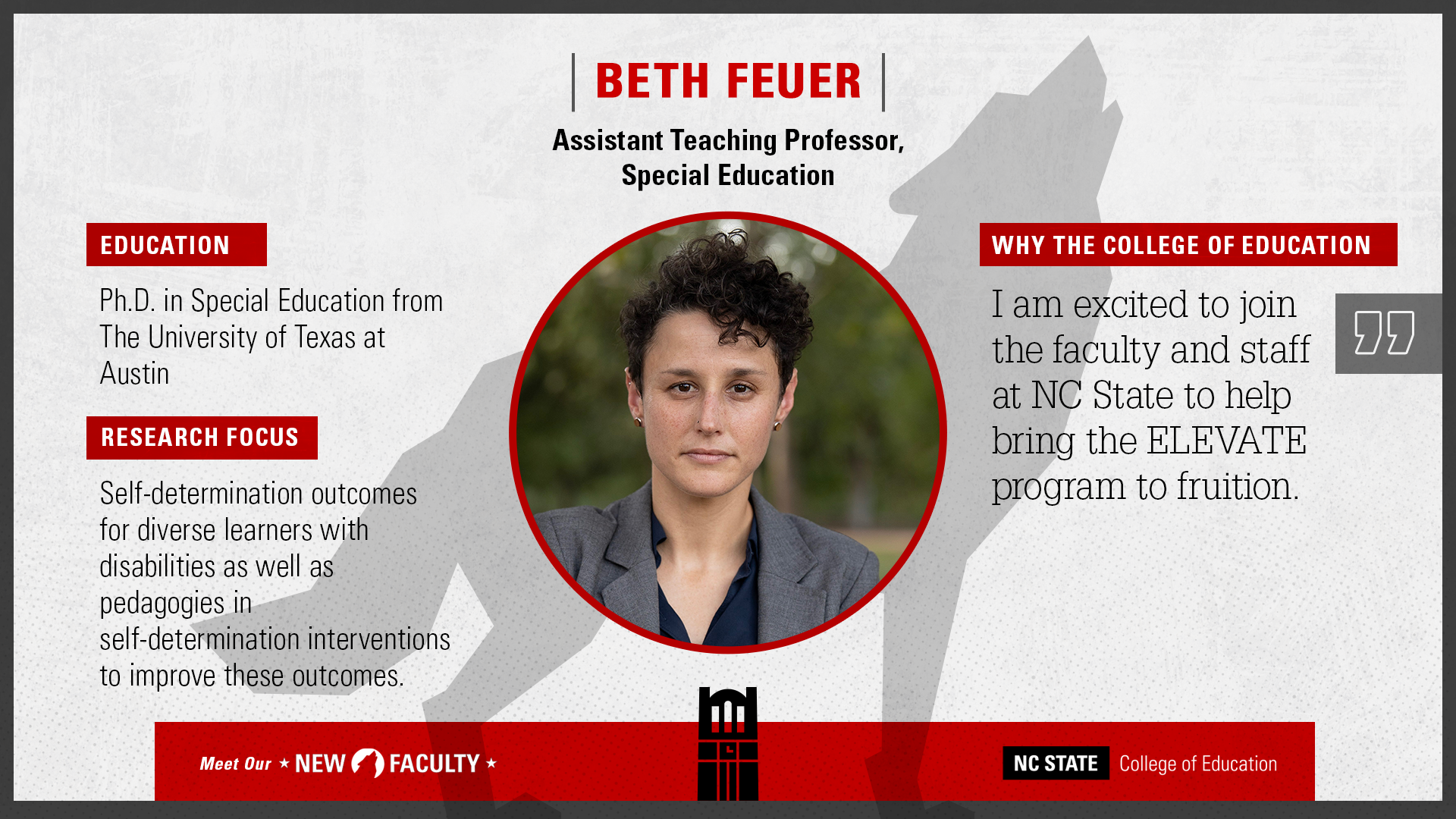Beth Feuer: ‘I Feel it is My Role to Cultivate a Classroom Environment Where Learners Are Safe to Share Their Diverse Opinions’


Beth Feuer Joins NC State College of Education as Assistant Teaching Professor in Special Education

Beth Feuer will join the NC State College of Education during the 2024-2025 academic year as an assistant teaching professor of special education, a role through which she will support NC State’s new Inclusive Post-secondary Education Program (IPSE) called Empowering Learning Experiences which Value Advocacy, Transition, and Employment, or ELEVATE.
Background
Feuer received her Ph.D. in Special Education with a specialty in equity and diversity from The University of Texas at Austin in 2024. Her research focuses on self-determination outcomes for diverse learners with disabilities as well as pedagogies in self-determination interventions to improve these outcomes.
Q&A with Beth Feuer
The following Q&A has been edited for length and clarity.
Why did you choose a career in education?
Through my involvement with Best Buddies, a club that links up students with and without disabilities in 1:1 friendship, I saw the benefits and positive impact on students with and without disabilities. My engagement in this organization really drove my desire to pursue a career in educating students with disabilities.
What inspired you to pursue a doctoral degree?
As I was teaching in public school, I became increasingly interested in how I could better support students with diverse identities with disabilities, and how to equip future special educators with the tools to meet the needs of this student population and become equity-focused educators. I was eager to dive into the research and expand my knowledge base on these topics, leading to the pursuit of my doctoral degree in special education.
What sparked your interest in your area of studies?
As a special educator engaged in transition planning, I collaborated with diverse students and their families to better understand their postsecondary goals and dreams, and taught students’ self-determination skills to facilitate the attainment of their goals. The personal experiences that I had with my students and their families led to a deeper curiosity of the research surrounding the topics of special education and educational equity, and how I could become a better educator to support this student population.
Notable Achievement
I can’t say that I can pinpoint just one moment that I’m particularly proud of, but I think it is really the combination of all the moments where I taught pre-service teachers a skill in the college classroom, and then was able to observe them put that skill or strategy into practice and reflect on their instruction in their fieldwork settings.
Teaching Philosophy
As an educator, I feel it is my role to cultivate a classroom environment where learners are safe to share their diverse opinions and experiences, feel a sense of agency, and where marginalized voices are centered and validated across content, and within the classroom environment. I utilize a strengths-based and student-centered approach, modeling for students what an inclusive classroom looks like. Additionally, I strive to reduce barriers to engagement and student marginalization within my classroom through the use of evidence-based instructional and high-leverage practices, and deliver content informed by culturally sustaining and critical pedagogies. Ultimately, I aim to create a learning environment that is deeply rooted in community, whereby students utilize and apply their funds of knowledge and personal experiences, and we work together to co-construct knowledge and develop new understandings from one another.
Impact on Students
It is my goal that students walk away from my classes more empowered and equipped with the tools they need to be better advocates for themselves and others. I want them to learn the essential skills, tools, and support necessary to have a sense of agency over their lives, and attain their educational, professional and personal goals.
Qualities of an Extraordinary Educator
I think what makes an extraordinary educator is someone who takes a genuine interest in their students and fosters a sense of community, intentionally making curriculum and content applicable and relevant to students’ lives and holds students to high expectations. In addition, an extraordinary educator is critically reflective of their own pedagogical practices, and is committed to equity and inclusion for all learners.
SDGs, Targets, and Indicators
| SDGs | Targets | Indicators |
|---|---|---|
| SDG 4: Quality Education | 4.5: Eliminate gender disparities in education and ensure equal access to all levels of education and vocational training for the vulnerable, including persons with disabilities | No specific indicators mentioned in the article |
| SDG 10: Reduced Inequalities | 10.2: By 2030, empower and promote the social, economic and political inclusion of all, irrespective of age, sex, disability, race, ethnicity, origin, religion or economic or other status | No specific indicators mentioned in the article |
| SDG 16: Peace, Justice, and Strong Institutions | 16.7: Ensure responsive, inclusive, participatory and representative decision-making at all levels | No specific indicators mentioned in the article |
1. Which SDGs are addressed or connected to the issues highlighted in the article?
- SDG 4: Quality Education
- SDG 10: Reduced Inequalities
- SDG 16: Peace, Justice, and Strong Institutions
Explanation:
The article discusses the appointment of Beth Feuer as an assistant teaching professor of special education, with a focus on equity and diversity. This aligns with SDG 4, which aims to ensure inclusive and equitable quality education for all. Additionally, the article mentions Feuer’s research on self-determination outcomes for diverse learners with disabilities, which relates to SDG 10, which aims to reduce inequalities and promote the inclusion of all individuals, including those with disabilities. Lastly, the article highlights Feuer’s teaching philosophy, which emphasizes creating an inclusive and participatory classroom environment, aligning with SDG 16’s goal of ensuring responsive and inclusive decision-making at all levels.
2. What specific targets under those SDGs can be identified based on the article’s content?
- Target 4.5: Eliminate gender disparities in education and ensure equal access to all levels of education and vocational training for the vulnerable, including persons with disabilities
- Target 10.2: By 2030, empower and promote the social, economic and political inclusion of all, irrespective of age, sex, disability, race, ethnicity, origin, religion or economic or other status
- Target 16.7: Ensure responsive, inclusive, participatory and representative decision-making at all levels
Explanation:
The article does not explicitly mention the specific targets under the SDGs. However, based on the content, we can infer that the following targets are relevant. Target 4.5 aims to eliminate gender disparities in education and ensure equal access to education and vocational training for vulnerable individuals, including those with disabilities. Target 10.2 focuses on promoting the social, economic, and political inclusion of all individuals, regardless of their age, sex, disability, race, ethnicity, origin, religion, or economic status. Target 16.7 aims to ensure responsive, inclusive, participatory, and representative decision-making at all levels.
3. Are there any indicators mentioned or implied in the article that can be used to measure progress towards the identified targets?
No specific indicators are mentioned or implied in the article that can be used to measure progress towards the identified targets.
SDGs, Targets, and Indicators
| SDGs | Targets | Indicators |
|---|---|---|
| SDG 4: Quality Education | 4.5: Eliminate gender disparities in education and ensure equal access to all levels of education and vocational training for the vulnerable, including persons with disabilities | No specific indicators mentioned in the article |
| SDG 10: Reduced Inequalities | 10.2: By 2030, empower and promote the social, economic and political inclusion of all, irrespective of age, sex, disability, race, ethnicity, origin, religion or economic or other status | No specific indicators mentioned in the article |
| SDG 16: Peace, Justice, and Strong Institutions | 16.7: Ensure responsive, inclusive, participatory and representative decision-making at all levels | No specific indicators mentioned in the article |
Source: ced.ncsu.edu








